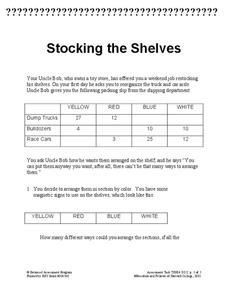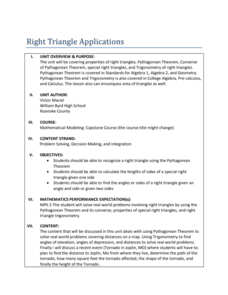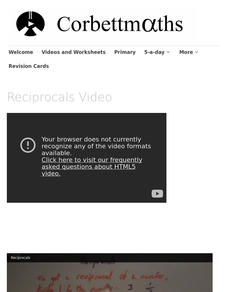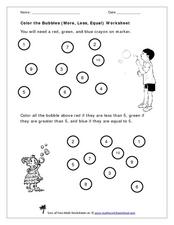CK-12 Foundation
Absolute Value: Picket Fence Painting
Painting a fence can be useful for more than just making your yard look good. A slider interactive has young mathematicians adjust the number of white fence panels. This activity helps in understanding how absolute value equations...
101 Questions
Best Triangle
What makes an equilateral triangle equilateral? It turns out it's much more than just the side lengths! Learners analyze four different triangles to determine the best equilateral triangle. They create a formula that they later use to...
101 Questions
Potatoes
Between 2000 and 2017, the cost of potatoes more than doubled in the United States. Pupils use the total cost of two types of potatoes to solve for the number of pounds of each type of potato. Then, they determine if the kitchen scale...
Mascil Project
Epidemics: Modelling with Mathematics
The Black Death epidemic is responsible for more than one million deaths in the United Kingdom. An inquiry-based activity has young scholars explore the rate of disease spread. They then analyze graphs showing data from epidemics such as...
Concord Consortium
Gestation and Longevity
Is the gestation length of an animal a predictor of the average life expectancy of that animal? Learners analyze similar data for more than 50 different animals. They choose a data display and draw conclusions from their graphs.
Concord Consortium
Stocking the Shelves
How many ways can you stock a shelf? It's probably more than you think! Young scholars use data in a frequency table to determine how many ways to stock a shelf given a specific constraint for types of groups. They then repeat the task...
CCSS Math Activities
Smarter Balanced Sample Items: High School Math – Target G
G is for generating equations. Scholars answer eight questions covering the SBAC Claim 1 Target G high school item specifications. They write one-variable and multi-variable equations and inequalities to model relationships between...
Illustrative Mathematics
Making 22 Seventeenths in Different Ways
There is more than one way to determine a sum. Scholars demonstrate their understanding of the decomposition of fractions similar to the decomposition of whole numbers. The short task requires pupils to determine which sums of fractions...
CK-12 Foundation
Percents as Decimals
In some cases, decimals are just easier to work with. An easy-to-use interactive shows how to convert percents to decimals. It then challenges learners to answer a set of questions, some of which include percents that are greater than...
Radford University
Right Triangle Applications: Lessons 1 and 2
Use right triangles for more than just mathematical problems. The first two lessons of a unit ask pupils determine distances between cities by using the Pythagorean Theorem and a map. To cement understanding, learners use trigonometric...
Radford University
Marking Starting Locations for the 400-Meter Dash Track and Field Event
No fair! I had to run more than they did! Young mathematicians first measure various lengths on a school track. They develop strategies and show calculations to prove that all participants will run the same length using a staggered...
US Department of Commerce
Make Data Speak
Data displays are more than just a bunch of numbers. Small groups access census results and create eye-catching data displays. Teams choose a statistic and collect data points for five locations. Classmates present their infographics to...
New Mexico State University
Ratio Rumble
Develop a potion of ratios. Learners play a matching game to make potions that follow a recipe. Pupils create equivalent ratios to make multiple recipes at a given time. As levels increase, ratios get more difficult, as they include...
Corbett Maths
Reciprocals
Reciprocals is more than just flipping a fraction. Pupils watch a video to see how to find the reciprocal of any number. Individuals practice finding reciprocals of numbers including whole numbers and decimals.
US Department of Commerce
Exploring Sampling Variability - Higher Education Attainment Across The United States
More education in statistics is always beneficial. Given cards that provide the proportion of adults with bachelor's degrees in 10 random US states, scholars individually determine the sample percentage of states in which more than 30...
Bowland
Hot Under the Collar
It is close enough for all practical purposes. Pupils see two methods to convert degrees Celsius to degrees Fahrenheit, one with exact numbers and another using estimation. Learners review both methods and determine when the estimation...
Gfletchy
Deep Freeze
Warm up to the idea of subtracting integers. After watching a video where the contents of a cup instantly freeze when tossed into the air, pupils estimate the air temperature of Duluth, Minnesota (where the video was made). They then use...
Flipped Math
Multiply Polynomials
Do not let the distributive property foil you. Individuals hear about the FOIL method to multiply two binomials and how it is nothing more than the distributive property. Pupils learn two methods of multiplying any two polynomials. They...
Flipped Math
Points, Lines, and Planes
Geometry is more than just vocabulary. Pupils learn the basic geometric definitions and how to identify and name points, lines, and planes. Though the first lesson is packed with related vocabulary, scholars experience four postulates...
Flipped Math
Prove Triangles Similar
Show more than one way to prove similarity. Scholars learn three different methods to show two triangles are similar, Angle-Angle, Side-Side-Side, and Side-Angle-Side. Pupils practice applying these methods to determine whether two given...
Curated OER
Compare Two Numbers: How Many Times More Than...?
Explore the concept of "how many times" where the word "times" is defined. Learners will determine the product and quotient in a word problem. Then use manipulatives to solve the problem. Finally, they will write in their math journals...
Curated OER
Ten More or Ten Less
Adding and subtracting 10 is easy once you understand the tricks! Learners first write numbers that are ten more than two double-digit numbers. Then, they find numbers ten less than two other double-digit numbers. An explanation on the...
Curated OER
Color the Bubbles (More, Less, Equal)
Combine coloring and number comparisons with your youngsters. They use color coding to identify numbers that are less than, greater than, or equal to five. The 20 numbers are enclosed in bubbles, making this more of a fun activity. Note...
Curated OER
Multiple Variables in an Equation
Young mathematicians apply problem-solving skills to equations that have more than one variable. They will work through the process to problem solve and discover the solution.

























